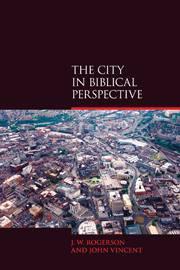Book contents
- Frontmatter
- Contents
- Preface
- Part 1 The city in the Old Testament
- Part 2 The City in the New Testament
- Chapter 4 Introduction: the Political Situation
- Chapter 5 The City and the World of Jesus
- Chapter 6 The City and the First Christians
- Chapter 7 Perspectives for our Cities
- Epilogue
- Bibliography
- Index of Biblical References
- Author Index
- Subject Index
Chapter 4 - Introduction: the Political Situation
from Part 2 - The City in the New Testament
- Frontmatter
- Contents
- Preface
- Part 1 The city in the Old Testament
- Part 2 The City in the New Testament
- Chapter 4 Introduction: the Political Situation
- Chapter 5 The City and the World of Jesus
- Chapter 6 The City and the First Christians
- Chapter 7 Perspectives for our Cities
- Epilogue
- Bibliography
- Index of Biblical References
- Author Index
- Subject Index
Summary
By the time of the first century, the whole of Palestine, like the whole of the eastern end of the Mediterranean, was part of the Roman Empire. Everywhere, Rome imposed its control over areas, by the erection of major cities, often with fortresses and citadels, with their characteristic streets and public places, their forums, theatres, temples and great houses. All these were in some cases introduced into existing local towns, in other cases built on “green” sites.
But alongside those Roman cities, many local indigenous villages, towns and even cities already existed, and were allowed to remain. Yet these locations were never “pure” or arcane or rustic. Most had already received in various ways the imprints of previous occupying nations and their varied cultures. Most Palestinian residential areas would already have had imposed upon them, or been willing absorbents for, elements from pre-Roman occupying forces – Persian (450–332 BCE), Greek (332–167), Seleucid/Syrian (197–37), and then Roman (37 BCE –132 CE). There were also the periods of the Maccabean rulers (166–63), and the Herodians (37 BCE –70 CE). Palestine in the first century bore the marks of influences and buildings from all these sources (Harding, 2003: 5–55).
- Type
- Chapter
- Information
- The City in Biblical Perspective , pp. 49 - 51Publisher: Acumen PublishingPrint publication year: 2009



